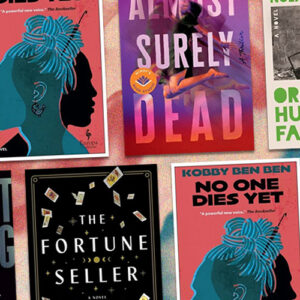I first saw Sliding Doors on VHS in 1999, the year after it released in theaters. I was eighteen and seeking my way back from my first real heartbreak. Mere days after an amicable split with my boyfriend, a slow drifting apart that was more bittersweet than painfully acute, he had called me up to say he was seeing someone new—my best friend. Then the pain rushed in. I slid the tape into my VCR expecting the kind of romantic comedy that would feel bad and good at the same time, like pressing on a bruise. (As it turned out, Sliding Doors was not a typical rom-com, something I’ll return to in a moment.) But it did resonate in unexpected ways.
In the opening sequence of the dual-timeline film, Gwyneth Paltrow’s character Helen gets fired from her job, and in one reality, catches the train and comes home to find her boyfriend in bed with another woman. Helen’s experience didn’t precisely mirror my own, but heartbreak has a way of shimmying from a TV screen or leeching from the pages of a novel, finding its way into your soft spots. (In the other reality, Helen misses the train and her boyfriend’s mistress has left by the time she makes it home, a sequence of events that only seems to launch her down a brighter path.)
Years later, when I began dreaming up the story that would become my dual-reality domestic thriller The Split, I was inspired by Sliding Doors—both the format and the dark turns taken over the course of a film most remember as a rom-com. Yes, there is a romance and the requisite miscommunication trope, and there are certainly funny moments, but the film’s billing as a romantic comedy is something I always found a bit of a mischaracterization. I’d argue Sliding Doors is a speculative drama, and indeed it was the darker moments that felt most poignant—infidelity, a mugging, miscarriage, death—along with the thought-provoking premise: can one small moment split your life in two? The dual-reality format wasn’t invented by writer-director Peter Howitt, but the film certainly popularized the concept, and following its release, “a sliding doors moment” came to mean a seemingly inconsequential moment in time with the power to alter the sequence of future events.
We’ve all experienced them, haven’t we? If we’d caught that train, gone out instead of staying in, said yes instead of no…how might our lives have taken a completely different path? My own marriage is the result of a sliding doors moment. My husband almost stayed home the night of the holiday party where we were introduced. And, in a minor echo of my high school heartbreak ten years prior, if the man I’d been casually dating at the time hadn’t called me that afternoon, telling me he was seeing someone new, I wouldn’t have been open to a new relationship in the first place. Our lives are filled with these tiny coincidences, choices, doors we decide to step through or close. And while the proposition that we’re all living our own version of Sliding Doors could certainly be the stuff of a great romance—my husband and I recently celebrated our twelfth wedding anniversary, for instance!—it can just as easily be fodder for a dark and twisty thriller. As a suspense writer, this is of course the path down which my mind is predisposed to travel.
In conceptualizing The Split, it felt important that my protagonist Jane’s sliding doors moment would hinge on a choice—not a coincidence. In the Peter Howitt film, Helen’s life splits in two when she either catches or misses a train in the London underground—the sliding doors that give the film its name. Her reality split is triggered by happenstance; she either successfully skirts a small child on the subway stairs in time to squeeze through the doors, or she is held up, and the doors close with Helen still on the platform. This is fitting for a rom-com (although I maintain this genre marker fails to fully capture the film) but for a thriller, I knew Jane’s reality split would need to result from a moment within her control: jump to her flighty younger sister’s rescue or put her foot down and let Esme take responsibility for herself. Jane’s response splits her life into two realities: one in which Esme comes to live with Jane in their childhood home, forcing the sisters to reckon with the darkness in their past and the distance between them now, and the other in which Esme vanishes into the night, leaving Jane tortured by regret.
Throughout The Split, Jane must reckon with the consequences of her decision—and reflect on the similarly life-altering consequences of an earlier decision from her childhood, an incident that set the tone for her strained relationship with Esme in the present. At one point, she wonders if there is another Jane out there, one who made a different choice on that long-ago night…
Applying the sliding doors format to a thriller was a fantastic creative challenge. Jane’s two timelines each involve a mystery, and each holds space for echoes of the other timeline—people, places, occurrences—that ripple through Jane’s two paths. A recent heartbreak. A new love. An ailing mother. A notebook. Secrets. Regrets.
Without giving too much away, I’ll conclude by saying that I also owe the ultimate direction Jane’s story takes to a recent re-watch of Sliding Doors, during which I was reminded of an important lesson about split-reality narratives: a story can grow many branches, but it only has one ending. Until the next sliding doors moment comes along.
***


















